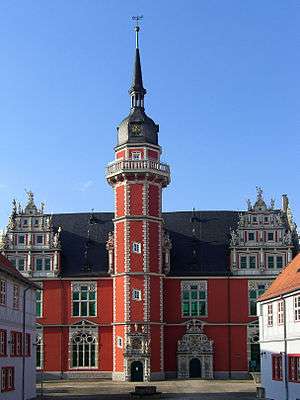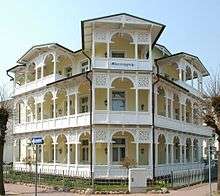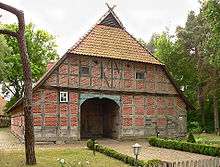List of architectural styles
An architectural style is characterized by the features that make a building or other structure notable and historically identifiable. A style may include such elements as form, method of construction, building materials, and regional character. Most architecture can be classified as a chronology of styles which changes over time reflecting changing fashions, beliefs and religions, or the emergence of new ideas, technology, or materials which make new styles possible.
Styles therefore emerge from the history of a society and are documented in the subject of architectural history. At any time several styles may be fashionable, and when a style changes it usually does so gradually, as architects learn and adapt to new ideas. Styles often spread to other places, so that the style at its source continues to develop in new ways while other countries follow with their own twist. A style may also spread through colonialism, either by foreign colonies learning from their home country, or by settlers moving to a new land. After a style has gone out of fashion, there are often revivals and re-interpretations. For instance, classicism has been revived many times and found new life as neoclassicism. Each time it is revived, it is different.
Vernacular architecture works slightly differently and is listed separately. It is the native method of construction used by local people, usually using labour-intensive methods and local materials, and usually for small structures such as rural cottages. It varies from region to region even within a country, and takes little account of national styles or technology. As western society has developed, vernacular styles have mostly become outmoded by new technology and national building standards.
Examples of styles
 Ancient Roman architecture: Colosseum, an amphitheater built in the 1st century AD, capable of seating 50,000 spectators
Ancient Roman architecture: Colosseum, an amphitheater built in the 1st century AD, capable of seating 50,000 spectators- Persian Islamic architecture from the 7th- to 9th-century period: the Shah Mosque, Naqsh-i Jahan Square, Iran




 Historicism: Resort architecture in Binz on Rugia Island, a specific style common in German seaside resorts
Historicism: Resort architecture in Binz on Rugia Island, a specific style common in German seaside resorts

Chronology of styles
Prehistoric
Early civilizations developed, often independently, in scattered locations around the globe. The architecture was often a mixture of styles in timber cut from local forests and stone hewn from local rocks. Most of the timber has gone, although the earthworks remain. Impressive, massive stone structures have survived for years.
- Neolithic 10,000-3000 BC
Ancient Americas
Mediterranean and Middle-East Civilizations
Ancient Near East and Mesopotamia
|
Iranian and Persian
|
Ancient Asian
Indic
Historic temple styles
|
SinicAlso |
Classical Antiquity
The architecture of Ancient Greece and Ancient Rome, derived from the ancient Mediterranean civilisations such as at Knossos on Crete. They developed highly refined systems for proportions and style, using mathematics and geometry.
- Classical 600 BC - 323 AD
- Ancient Greek 776-265 BC
- Roman 753 BC – 663 AD
- Herodian 37-4 BC (Judea)
- Early Christian 100-500
- Byzantine 527 (Sofia) - 1520
The Dark Ages
The European "Dark Ages" are generally taken to run from the end of the Roman Empire, around 400 AD, to around 1000 AD. Relatively little is known of this period, but Christianity (spread by the Romans) was already making a significant impact on European culture, and the Romans left a technological and social legacy.
Europe
|
Medieval Europe
The dominance of the Church over everyday life was expressed in grand spiritual designs which emphasized piety and sobriety. The Romanesque style was simple and austere. The Gothic style heightened the effect with heavenly spires, pointed arches and religious carvings.[1]
Romanesque
Associated styles
|
Gothic1140-1520
|
Asian architecture contemporary with the Dark Ages and medieval Europe
Japanese
ChineseDravidian and Vesara temple styles (India)
|
Other Indian styles
Islamic |
American architecture contemporary with the Dark and Middle Ages
- Puuc
- Maya architecture
- Aztec (ca. 14th century - 1521)
The Renaissance and its successors
1425-1660. The Renaissance began in Italy and spread through Europe, rebelling against the all-powerful Church, by placing Man at the centre of his world instead of God.[2] The Gothic spires and pointed arches were replaced by classical domes and rounded arches, with comfortable spaces and entertaining details, in a celebration of humanity. The Baroque style was a florid development of this 200 years later, largely by the Catholic Church to restate its religious values.[3]
United Kingdom
Spain and Portugal
Colonial
|
Baroque1600-1800, up to 1900
|
Asian architecture contemporary with Renaissance and post-Renaissance Europe
Japanese
- Shoin-zukuri (1560s - 1860s)
- Sukiya-zukuri (1530s - present)
- Minka (Japanese commoner or folk architecture)
- Gassho-zukuri (Edo period and later)
- Honmune-zukuri (Edo period and later)
Indian
- Indo-Islamic
- Mughal 1540-? (India, Pakistan, Bangladesh)
- Sharqi aka Janpur Style
Neoclassicism
1720-1837 and onwards. A time often depicted as a rural idyll by the great painters, but in fact was a hive of early industrial activity, with small kilns and workshops springing up wherever materials could be mined or manufactured. After the Renaissance, neoclassical forms were developed and refined into new styles for public buildings and the gentry.
Neoclassical
Revivalism and OrientalismLate 19th and early 20th centuries. The Victorian Era was a time of giant leaps forward in technology and society, such as iron bridges, aqueducts, sewer systems, roads, canals, trains, and factories. As engineers, inventors, and businessmen they reshaped much of the British Empire, including the UK, India, Australia, South Africa, and Canada, and influenced Europe and the United States. Architecturally, they were revivalists who modified old styles to suit new purposes.
Rural styles
Reactions to the Industrial Revolution
Modernism and other styles contemporary with modernism1880 onwards. The Industrial Revolution had brought steel, plate glass, and mass-produced components. These enabled a brave new world of bold structural frames, with clean lines and plain or shiny surfaces. In the early stages, a popular motto was "decoration is a crime". In the Eastern Bloc the Communists rejected the Western Bloc's 'decadent' ways, and modernism developed in a markedly more bureaucratic, sombre, and monumental fashion.
Post-Modernism and early 21st century styles
Fortified styles
Vernacular stylesThis list is incomplete; you can help by expanding it.
Alphabetical listing
See also
References
Further reading
External links
|

